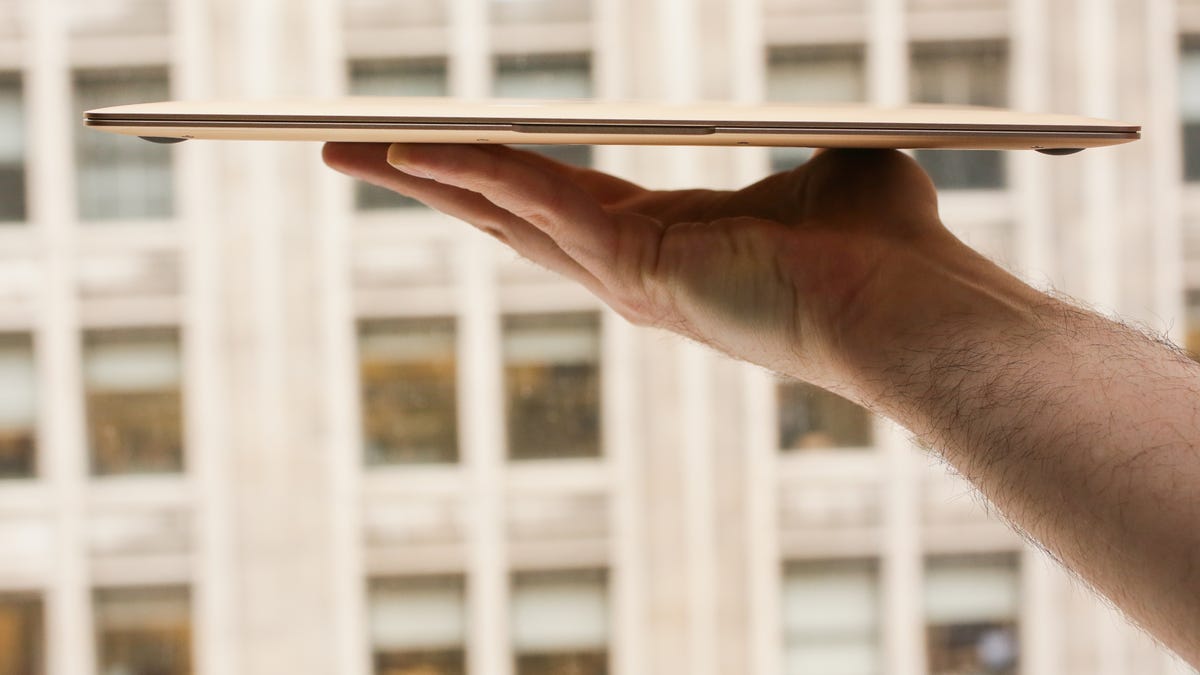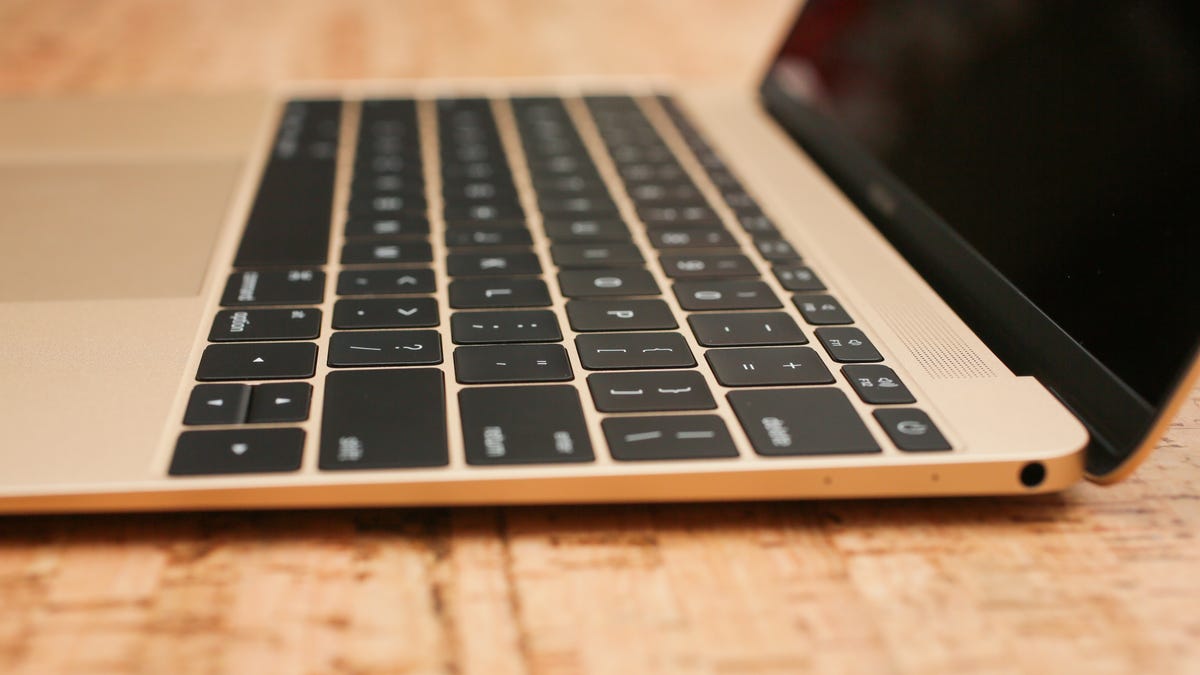It’s been nearly one full year since I reviewed Apple’s 12-inch MacBook. That slim, light system was not only Apple’s only completely new laptop design since the 2012 MacBook Pro, but also among its most controversial.
The knocks against this system — an odd-man-out, not part of either the Air or Pro MacBook lines — were numerous. Its screen was too small; the keyboard too shallow; not enough ports; no MagSafe power connection; underpowered, even compared to the base MacBook Air; and battery life that didn’t measure up to the MacBook standard.
All legitimate concerns, and ones that I shared both when the 12-inch MacBook was announced in March of 2015, and when I got my hands on the final product several weeks later in early April. In my original review of the $1,299 MacBook (£1,049 or AU$1,799), I was impressed with its overall design, the excellent high-res display, and extreme portability, but cautioned that it wasn’t the laptop for everybody, or for all-day work. The single USB-C port could lock out most of your accessories (without a pricey adaptor) and the performance and battery life from the first-gen Intel Core M processor was not on par with mainstream Core i5 laptops that cost hundreds less.


Sarah Tew / CNET
I gave the system a qualified thumbs up, and opined that, “The new 12-inch MacBook won’t do everything and isn’t for everyone. But its strictly enforced minimalism will make this laptop the model that industrial designers will strive to copy for the next several years.”
In a way, that echoes the complaints about the first-gen MacBook Air when it was first introduced in 2008. The original Air was also criticized for missing then-popular ports and connections, such as an Ethernet and VGA, and it included just a single USB port.
Imitated, but never duplicated
One year later, a handful of laptops and hybrids have followed in the 12-inch MacBook’s footsteps, with Core M processors and USB-C ports, offering a stripped down experience that favors instant gratification and ease of access over long-term performance and extra features. Examples run from the Asus Transformer Book T300 Chi to the brand new Samsung Galaxy Tab Pro S. Despite offering similar specs, these other systems lack one of the secret ingredients that helped the 12-inch MacBook work so well — the OS X operating system. Apple’s computer OS is simply better at tasks that benefit a small pick-up-and-play laptop, from instantly (and reliably) waking from sleep to easy app switching through multi-finger touchpad gestures to simple file previews via a tap of the space bar. It does lack a touch screen, something standard on nearly every new Windows laptop in its price class, but the especially intuitive multitouch touchpad gestures make up for a least some of that missing functionality.
That’s why, despite testing and using nearly every new laptop or 2-in-1 hybrid released over the past year, I find myself returning again and again to the 12-inch MacBook. It’s become my default go-to for those times when I need a laptop that’s quick and easy to pick up and use. The MacBook has that same magic quality as the iPad did, which is that it makes for a perfect living room couch device, as it’s lightweight, springs to life the moment I lift the lid, and is small enough that it doesn’t get in the way.
Those same qualities also make it the first system I reach for when running out for a coffee shop writing session, where I can easily tap out thousands of words per week. The highest compliment I can pay the MacBook is that I usually forget any of the hardware limitations once I get into the writing zone, where the system does what every productivity machine should do, fade into the background.


Sarah Tew / CNET
But it’s still not for everyone
I’ve only run into a few issues with the machine, using it anywhere from a few times per week to almost daily. When working on a very large document, many tens of thousands of words long, plus running two web browsers with multiple tabs open in each, the MacBook would start to get bogged down and feel sluggish. I also very recently innocently grabbed the MacBook and tried to insert a USB key into it — forgetting for a moment that it has only a single USB-C port for data, power, video and accessories. Not having a USB-C to USB-A adaptor handy, I was forced to upload my docs to the cloud from another machine and re-download them onto the MacBook.
The very shallow keyboard isn’t the most comfortable for long-form typing, but also not as clacky as the shallow keys on a Surface Pro keyboard. It’ll never be your favorite laptop keyboard, but I found it wore on me better than expected. The touchpad remains excellent, and still miles beyond any Windows system touchpad, thanks to Apple’s multi-touch gesture support.


Sarah Tew / CNET
Battery life, which we originally reported as 11 hours for offline video streaming and five hours for online video streaming, has diminished a bit since last year, but remains fine, even if nowhere near what other MacBooks get. I have yet to come close to filling the default 256GB SSD, partially because so much of what we do with laptops happens remotely on cloud servers now, from work docs to video streaming.
The $1,300 dilemma
When people ask me which MacBook they should buy, my default suggestion has usually been the 13-inch MacBook Pro. It starts at the same price as the 12-inch MacBook, has a great battery, powerful Core i5 processor, and plenty of ports and connections. But, it’s also bigger and heavier, and not nearly as effortlessly portable.
That MacBook Pro is still the “safe” choice, and the MacBook Air remains a comparative “budget” choice (about $300 to $400 cheaper), albeit without the awesome Retina high-res screen found on all other non-Air MacBooks, and half the default storage. but more and more, I’m drawn to the 12-inch MacBook, compromises and all. Looking back over the past year, it’s the system I’ve most often grabbed for mission critical on-the-go use, and that makes me think my original qualified recommendation was overly cautious.
That said, this is still a hefty $1,300 investment, and similar specs can be found for less, including in the new Samsung Galaxy Tab Pro S, which combines a newer Core M CPU with a touchscreen Windows 10 tablet and detachable keyboard cover, all for $899.
And, of course, there’s the whole issue of Apple competing with itself, touting the similarly sized 12.9-inch iPad Pro (and the new 9.7-inch iPad expected to be announced on Monday). Throw in the keyboard and Apple Pencil, and you’ve got a sorta kinda laptop that adds the touch screen lacking on the MacBook — for almost the exact same price. And yet, as good as iOS is, it still doesn’t seem to have the sort of muscular apps many of us need for everyday work.
A few improvements would make it easier to splurge on a specialized system like the 12-inch MacBook: Most notably, an upgrade to the new generation of Core M chips from Intel and a second port (even a second USB-C would be a nice step up).
Updated Mac hardware isn’t expected at the March 21 Apple event, but if Apple sticks to its annual upgrade cycle for laptops, we could see at least a spec boost sometime between now and Apple’s Worldwide Developers Conference (WWDC) in June.
But whenever a second generation 12-inch MacBook hits, I suspect it’s going to win over a lot of shoppers who have been sitting on the fence.




